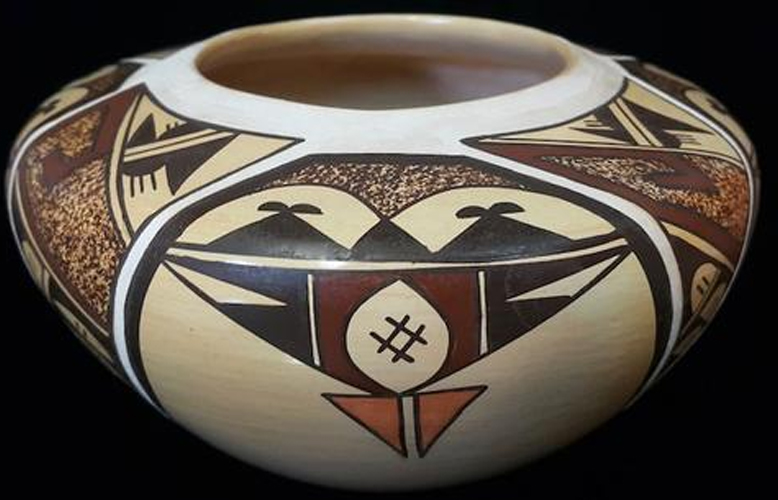(Photo courtesy of Raven Makes Gallery)
Three great plateaus of sun baked, wind scrubbed Earth rise into the sky in Northeastern Arizona. These island mesas of smooth yellow sandstone boulders, laying in both tight, neat stacks and pell-mell jumbles, offer elevated vistas that seemingly reach beyond distant horizons and into the dimension of timelessness. Long ago, a people were drawn to settle these mesas that provide secluded natural springs. Whether or not they were the first to occupy these Islands in the Sky matters not, the Hopi stayed. 1000 years later, they remain, their traditions still very much alive.
Sonwai, Verma Nequatewa of 3rd Mesa, became a preeminent Native American jeweler 30 years ago, after apprenticing for 25 years beside her uncle, the legendary Charles Loloma. Charles redefined the concept of Native American jewelry; his works are revered for their innovation, the skill required to create them, and their astounding beauty. First learning the basics of metallurgy and lapidary from her uncle, then the guiding concepts of form and content, Verma eventually came to understand the rich subtleties and nuances that define a true masterpiece from a fine work of art. She carries forward the understanding that, when a work is being constructed, there is only absolute precision with every detail. The end result is jewelry that has distinguished styling, is refined yet visionary, and leads one to consider something distant and ageless.
The Hopi are structured as a matriarchal society. Upon marrying, the man goes to live with the woman’s family, adopting her clan. A sovereign nation, each village is divided into clans and governed by a headman or chief, who also serves as the spiritual leader. Dry land farming and ranching are the primary livelihoods.
Pesavensi, Donna Humetewa of 3rd Mesa, belongs to the Rabbit/Tobacco Clans. She makes her paints using local earthen and mineral pigments; her depictions of patterns, land and sky, along with sacred symbols literally reflect the beauty surrounding her home. Upon concluding a career working for the Hopi Tribe, she began painting. Donna, who had long worked with fiber arts, found a mentor in James McGrath. The former Art Director of the Institute of American Indian Art college encouraged her to use the resources from her home when creating the works and to follow her intuitions. Her warm earth tone images are now seen each year at the juried Santa Fe Indian Market and Heard Shows.
The Hopi attribute success to their Spiritual Ways, known as the Katsina religion. Their ceremonies and dances are prayers for moisture, germination and the well-being of everyone. They believe their land to be the center of the universe, their prayers essential to the harmony of humanity. Many Native American tribes acknowledge the Hopi as a model for peace and sustainability; theologians note a similarity between the Hopi and traditional Tibetans.
Dorothy Ami comes from the ancient pottery making village of Polacca on 1st Mesa. She began making pottery in her late teens. It was in her late 20’s when her cousin, the celebrated potter Mark Tahbo, began guiding her and she evolved into an award-winning potter herself. Dorothy’s works are fully traditional—coiled with local earth materials, fired outside with cedar wood and sheep manure, stone polished and painted with natural clay pigments, bee-weed being used for the black.
Sonwai, Pesavensi, and Dorothy will be offering a show and exhibition of their works September 28-30, with an Artists Reception on Friday from 4 to 7pm. They will offer an open forum, question and answer session on Saturday from 1:30-2:30pm. All events will take place at Raven Makes Gallery.

